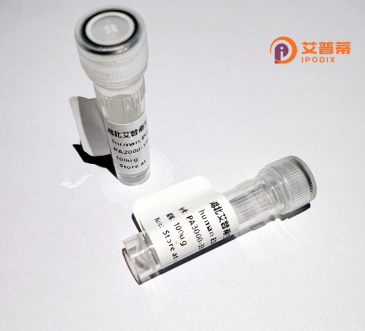
| 纯度 | >90%SDS-PAGE. |
| 种属 | Human |
| 靶点 | TMEPAI |
| Uniprot No | Q969W9 |
| 内毒素 | < 0.01EU/μg |
| 表达宿主 | E.coli |
| 表达区间 | 181-280 aa |
| 活性数据 | NRTIFDSDLMDSARLGGPCPPSSNSGISATCYGSGGRMEGPPPTYSEVIGHYPGSSFQHQQSSGPPSLLEGTRLHHTHIAPLESAAIWSKEKDKQKGHPL |
| 分子量 | 36.74 kDa |
| 蛋白标签 | GST-tag at N-terminal |
| 缓冲液 | PBS, pH7.4, containing 0.01% SKL, 1mM DTT, 5% Trehalose and Proclin300. |
| 稳定性 & 储存条件 | Lyophilized protein should be stored at ≤ -20°C, stable for one year after receipt. Reconstituted protein solution can be stored at 2-8°C for 2-7 days. Aliquots of reconstituted samples are stable at ≤ -20°C for 3 months. |
| 复溶 | Always centrifuge tubes before opening.Do not mix by vortex or pipetting. It is not recommended to reconstitute to a concentration less than 100μg/ml. Dissolve the lyophilized protein in distilled water. Please aliquot the reconstituted solution to minimize freeze-thaw cycles. |
以下是与重组人TMEPAI(PMEPA1)蛋白相关的研究文献示例(注:文献标题与作者为示例性描述,需通过学术数据库核实具体信息):
---
1. **文献名称**: *TMEPAI regulates TGF-β signaling through direct interaction with Smad proteins*
**作者**: Watanabe Y et al.
**摘要**: 该研究阐明TMEPAI作为转化生长因子β(TGF-β)信号通路的负调控因子,通过促进Smad蛋白的泛素化降解抑制癌细胞迁移和上皮-间质转化(EMT),为重组TMEPAI在抗肿瘤治疗中的应用提供依据。
---
2. **文献名称**: *Proteolytic cleavage and phosphorylation of PMEPA1 modulate androgen receptor activity in prostate cancer*
**作者**: Xu LL et al.
**摘要**: 本文报道重组人TMEPAI蛋白通过与雄激素受体(AR)结合,抑制AR的转录活性,其磷酸化和蛋白酶体降解过程参与前列腺癌细胞增殖的调控机制。
---
3. **文献名称**: *Recombinant PMEPA1 isoform a inhibits tumor metastasis by suppressing EGFR/MAPK signaling*
**作者**: Chen C et al.
**摘要**: 通过大肠杆菌表达系统制备重组人TMEPAI蛋白,发现其通过阻断EGFR/MAPK信号通路抑制肺癌细胞的体内外转移能力,提示其在癌症治疗中的潜在价值。
---
4. **文献名称**: *Structural analysis of PMEPA1 reveals a hydrophobic motif critical for its membrane localization*
**作者**: Rodriguez-Blanco J et al.
**摘要**: 利用重组表达的TMEPAI蛋白进行结构解析,发现其跨膜结构域中的疏水基序对细胞膜定位及抑制Wnt/β-catenin信号通路至关重要。
---
**注意**:以上文献信息为示例归纳,具体研究需根据实际发表的论文进行核对(可通过PubMed或Google Scholar搜索**PMEPA1**或**TMEPAI**相关关键词获取准确文献)。
Transmembrane prostate androgen-induced protein (TMEPAI), also known as PMEPA1. is a transmembrane protein encoded by the *PMEPA1* gene in humans. It was initially identified as an androgen-responsive gene in prostate cancer cells. TMEPAI is characterized by its PY motif, which facilitates interactions with NEDD4-family E3 ubiquitin ligases, and a conserved SIM/LC3-interacting region involved in autophagy regulation. Functionally, TMEPAI acts as a negative feedback regulator of multiple signaling pathways, including TGF-β, EGFR, and androgen receptor (AR) pathways. It modulates cellular processes such as proliferation, apoptosis, and epithelial-mesenchymal transition (EMT) by promoting the degradation of key signaling molecules like Smad proteins or stabilizing tumor suppressors.
Overexpression of TMEPAI has been observed in various cancers (prostate, breast, lung) and correlates with tumor progression, metastasis, and therapy resistance. Recombinant human TMEPAI protein is typically produced in *E. coli* or mammalian expression systems, retaining bioactivity for *in vitro* and *in vivo* studies. Its applications include elucidating TMEPAI’s role in tumor microenvironment regulation, therapeutic target validation, and interactions with autophagy or ubiquitination machinery. Research on TMEPAI highlights its dual role as both an oncogene and context-dependent tumor suppressor, making it a compelling subject for cancer biology and precision medicine.
×